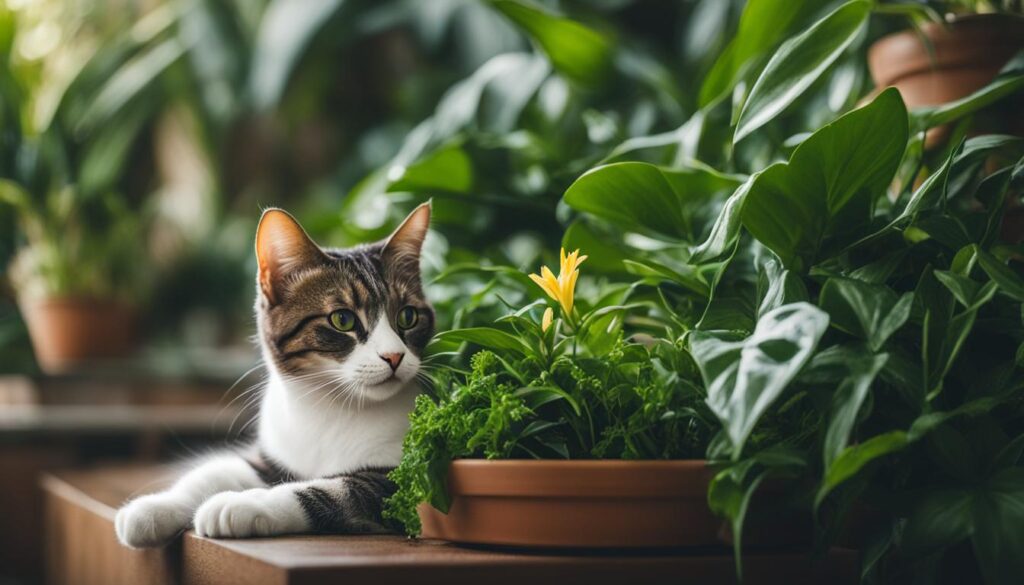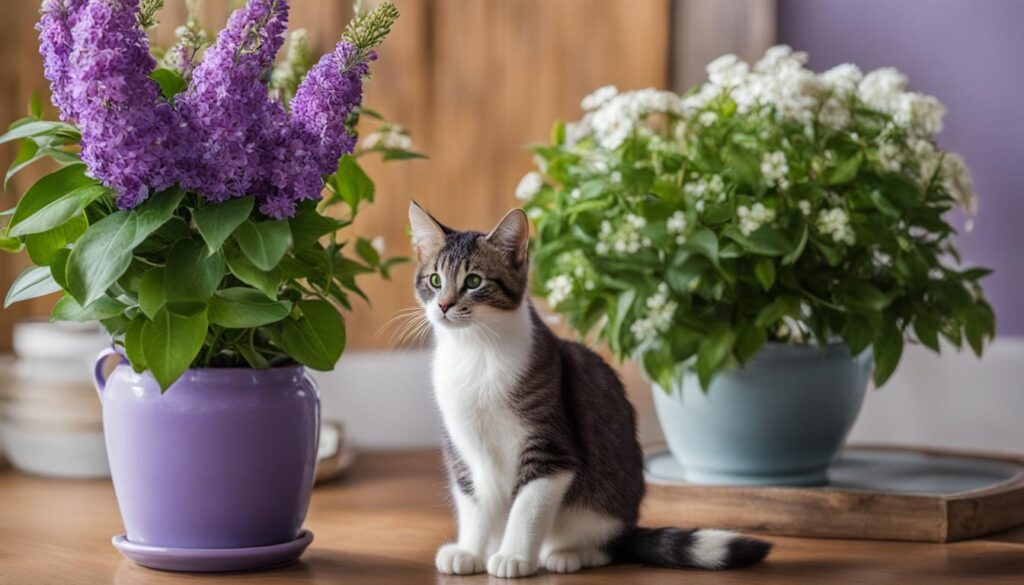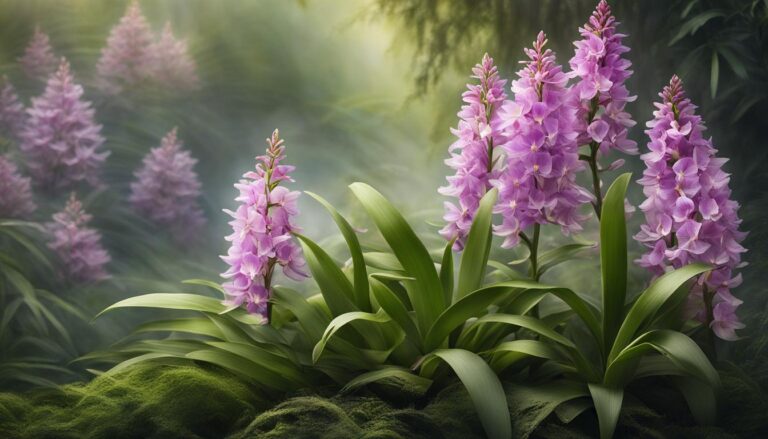Orchids are a popular choice for plant lovers, but if you have cats, you may be wondering if these beautiful flowers are safe to have in your home. In this article, we’ll explore the topic of orchid toxicity in cats and provide you with important information to ensure the safety of your feline friend.
Wichtigste Erkenntnisse
- Orchids are not toxic to cats, but ingestion can cause stomach upset.
- Chemicals in fertilizers and pesticides used on orchids can be harmful to cats.
- Prevent cats from eating orchids and opt for pet-friendly products.
- Monitor cats for any signs of gastrointestinal distress after contact with orchids.
- There are many other toxic plants to avoid if you have cats.
Understanding Orchids and Their Appeal
Orchids are a beloved choice among plant enthusiasts, offering a wide variety of beautiful and fragrant blooms. With over 800 different types and more than 25,000 species, orchids come in an array of colors, shapes, and sizes, making them a captivating addition to any home or garden.
These exquisite flowers have gained popularity due to their unique and elegant appearance. The intricate patterns and vibrant hues of orchid petals make them a captivating sight for plant lovers. Whether displayed as a solitary potted plant or arranged in a stunning bouquet, orchids add a touch of sophistication and natural beauty to any space.
Not only are orchids visually appealing, but many species also emit a delightful fragrance. From the intoxicating vanilla scent of the Vanda orchid to the delicate floral aroma of the Phalaenopsis, fragrant orchids can create a pleasant and inviting atmosphere in your home. Their captivating smell can be enjoyed for weeks or even months, making them a delightful choice for those who appreciate the sensory delights of plant life.
| Types of Orchids | Beschreibung |
|---|---|
| Cymbidium | Known for its long-lasting blooms and vibrant colors, Cymbidium orchids are popular in floral arrangements. |
| Phalaenopsis | Commonly referred to as moth orchids, Phalaenopsis orchids are easy to care for and feature large, showy flowers. |
| Dendrobium | Dendrobium orchids come in a wide variety of shapes and sizes, with many species producing clusters of blooms. |
| Cattleya | Known for their vibrant colors and intricate patterns, Cattleya orchids are often used as cut flowers and corsages. |
Due to their breathtaking appeal, orchids have become a favorite choice among plant lovers. Whether you are an experienced gardener or a beginner, these captivating flowers can bring joy and beauty to your home, making them an excellent addition to any collection of houseplants.
Orchid Enthusiasts Quote
“Orchids are like pieces of art that nature has created. The diversity and beauty of these flowers never fail to amaze me. The delicate petals, vibrant colors, and enchanting fragrance make orchids a true treasure for any plant lover.” – Maria Turner, Orchid Enthusiast
- Orchids are visually appealing due to their unique and elegant appearance.
- Many species of orchids emit a delightful fragrance, adding to their appeal.
- There are various types of orchids, each with its own distinct characteristics and beauty.
- Orchids have gained popularity among plant enthusiasts for their captivating beauty and wide range of options.
Are Orchids Safe for Cats?
Orchids are considered safe for cats as they are not toxic to them. However, it’s important to prevent cats from grazing on the plants to avoid any potential stomach upset. While orchids themselves may not pose a risk, it’s essential to be cautious about the chemicals used on them. Fertilizers, insecticides, and pesticides can be harmful to cats if ingested. Therefore, it is advisable to use pet-friendly, organic products when caring for orchids to ensure the safety of your feline companion.
Although orchids are generally safe for cats, ingestion can still cause gastrointestinal distress such as vomiting and diarrhea. To prevent any issues, it is recommended to keep orchids in a spot where cats cannot access them. Consider using hanging baskets or wall mounts to keep the plants out of reach. Additionally, offering cats alternative options for chewing, such as safe indoor cat grass or toys, can redirect their attention away from the orchids.
To summarize, while orchids themselves are non-toxic to cats, it’s crucial to take precautions and prevent cats from eating them. The chemicals used on orchids can be harmful to cats, so using pet-friendly products is recommended. By keeping orchids out of reach, providing alternative chewing options, and staying aware of other toxic plants, you can maintain a pet-friendly environment and enjoy the beauty of orchids without compromising your feline friend’s safety.
| Orchids and Cats | Risks and Precautions |
|---|---|
| Orchids are not toxic to cats | Prevent cats from grazing on orchids |
| Ensure chemicals used on orchids are pet-friendly | Keep orchids in a spot cats cannot access |
| Offer cats alternative chewing options | |
| Be aware of other toxic plants |
Tips for Keeping Cats and Orchids Separate
To ensure that your cats and orchids can peacefully coexist, it’s important to implement some practical strategies to keep them apart. Here are some helpful tips:
Create a Safe Placement for Orchids
First and foremost, consider the placement of your orchids. Keep them in areas where your cats cannot reach them, such as high shelves, hanging baskets, or secured wall mounts. This will prevent your curious feline friends from nibbling on the delicate flowers or knocking over the pots. By creating a safe distance between your cats and orchids, you can minimize the risk of any potential issues.
Invest in Cat-Proofing Measures
Cats are known for their agility and curiosity, so it’s essential to implement cat-proofing measures to keep them away from your orchids. Consider using deterrents like double-sided tape, aluminum foil, or citrus-scented sprays on the surfaces near your orchids. Cats usually dislike the texture or smell of these items and are less likely to venture near them. Additionally, you can create physical barriers, such as baby gates or decorative screens, to restrict your cats’ access to certain areas of your home where you have orchids displayed.
Offer Alternative Chewing Options
Cats may be attracted to the texture of orchid leaves or flowers, which could lead to them nibbling on them. To redirect their chewing behavior, provide alternative options that are safe and cat-friendly. Indoor cat grass and chew toys specifically designed for cats can help satisfy their urge to chew and distract them from your orchids. By offering appropriate chewing alternatives, you can protect both your cats and your beloved orchids.
| Tip | Beschreibung |
|---|---|
| Safe Placement | Create a high or secured location for orchids to keep them out of your cats’ reach. |
| Cat-Proofing Measures | Use deterrents or physical barriers to prevent cats from accessing your orchids. |
| Alternative Chewing Options | Provide indoor cat grass and cat-friendly chew toys to redirect chewing behavior away from orchids. |
By following these tips, you can ensure that your cats and orchids can peacefully coexist in your home. Remember, the safety and well-being of your feline companions should always be a top priority while enjoying the beauty of orchids.
Other Toxic Plants to Avoid for Cats
While orchids are safe for cats, it’s important to be aware of other plants that can be toxic to our feline friends. Here are some common toxic plants that you should avoid having in your home or yard if you have cats:
- Lilies: Many species of lilies, including Easter lilies, tiger lilies, and daylilies, can be extremely toxic to cats. Ingestion of any part of the plant, including the pollen and water from the vase, can lead to kidney failure and even death.
- Tulips: All parts of the tulip plant, especially the bulb, contain toxins that can cause gastrointestinal irritation, drooling, and even convulsions if ingested by cats.
- Daffodils: Daffodils contain toxic alkaloids that can cause vomiting, diarrhea, and even heart arrhythmias in cats. The bulbs are particularly dangerous if chewed or ingested.
- Amaryllis: The bulbs of amaryllis plants are highly toxic to cats and can cause vomiting, diarrhea, abdominal pain, and even tremors and seizures. Keep these plants out of reach to prevent any accidental ingestion.
- Peace lilies: Peace lilies, also known as spaths, are popular houseplants but can be toxic to cats. Ingestion can cause irritation of the mouth, tongue, and lips, as well as difficulty swallowing and drooling.
It’s important to remember that this is not an exhaustive list, and there are many other plants that can be harmful to cats. If you’re unsure about the safety of a plant, it’s best to consult with a veterinarian or refer to the ASPCA’s comprehensive list of toxic and non-toxic plants for cats.
Creating a safe environment for cats involves being mindful of the plants we bring into our homes and yards. By avoiding toxic plants like lilies, tulips, daffodils, amaryllis, and peace lilies, we can help prevent any potential harm to our beloved feline companions.
Table: Common Toxic Plants for Cats
| Plant | Toxic Parts | Symptome |
|---|---|---|
| Lilies | All parts, including pollen and water from the vase | Kidney failure, vomiting, drooling, death |
| Tulips | All parts, especially the bulb | Gastrointestinal irritation, drooling, convulsions |
| Daffodils | All parts, especially the bulb | Vomiting, diarrhea, heart arrhythmias |
| Amaryllis | Bulb | Vomiting, diarrhea, abdominal pain, tremors, seizures |
| Friedenslilien | All parts | Mouth, tongue, and lip irritation, difficulty swallowing, drooling |
Remember, the safety of our cats is our responsibility, and by being aware of the plants that can be toxic to them, we can create a secure environment where they can thrive.

Cat-Friendly Plants: Creating a Safe and Beautiful Environment for Your Feline Friend
When it comes to creating a pet-friendly environment, it’s important to consider the safety of your furry friends. If you’re a cat owner who also loves plants, you’ll be happy to know that there are plenty of non-toxic houseplants that can coexist peacefully with your cats. By choosing cat-friendly plants, you can create a safe and beautiful environment that both you and your feline companion can enjoy.
So, what are some safe plants for cats? African violet is a popular choice, known for its vibrant flowers and low maintenance. Boston fern is another option, with its lush green fronds adding a touch of nature to any room. Spider plants are not only visually appealing with their cascading leaves, but they also act as natural air purifiers. And if you’re looking for a beautiful orchid that is safe for cats, the moth orchid is a great choice.
Creating a cat-friendly environment goes beyond choosing the right plants. It’s important to consider their placement as well. Place plants in areas that are out of reach for your cats, such as hanging baskets or high shelves. This will prevent any accidental nibbling or digging. Offering alternative cat-friendly options, such as indoor cat grass or catnip toys, can also redirect their attention away from your plants. By taking these simple steps, you can ensure that your cats and plants can peacefully coexist in your home.
| Cat-Friendly Plants | Beschreibung |
|---|---|
| African violet | A vibrant flowering plant that requires minimal care. |
| Boston fern | A lush green fern that adds a touch of nature to any room. |
| Spider plant | A visually appealing plant that acts as a natural air purifier. |
| Moth orchid | A beautiful orchid that is safe for cats. |
By incorporating cat-friendly plants into your home, you can create a safe and inviting space for both you and your cats. Remember to always research and verify the safety of any plants before bringing them into your home. With a little bit of planning and consideration, you can create a pet-friendly environment that allows you to enjoy the beauty of nature while keeping your feline friends safe and happy.

Non-Toxic Plants for Cats
Choosing non-toxic houseplants ensures the well-being of your cats. Here are a few more examples of cat-friendly plants:
- Christmas cactus
- Areca palm
- Bamboo palm
- Phalaenopsis orchid
These plants not only provide aesthetic value but also offer a safe environment for your beloved feline companions. Keep in mind that while these plants are non-toxic, it’s still important to supervise your cats and prevent them from excessively chewing or digging around the plants.
Schlussfolgerung
In conclusion, orchids are safe for cats and can be enjoyed in a pet-friendly environment. While orchids themselves are not toxic to cats, it’s important to prevent them from grazing on the plants as ingestion can lead to stomach upset. By taking a few precautions, you can ensure the safety of your feline friend while still enjoying the beauty of orchids.
To maintain a pet-friendly environment, keep orchids out of reach of cats. Consider placing them in hanging baskets or wall mounts where cats cannot access them. Additionally, offer alternative chewing options, such as safe indoor cat grass or cat toys, to redirect their attention away from the orchids.
It’s also essential to be aware of other toxic plants that can be harmful to cats. Avoid having plants like lilies, tulips, daffodils, amaryllis, and peace lilies in your home or yard. Research and ensure that any plants you bring into your home are safe for cats, utilizing resources like the comprehensive list of toxic and non-toxic plants provided by the ASPCA.
By following these guidelines, you can create a pet-friendly environment that allows you to enjoy the beauty of orchids while keeping your beloved cat safe. Always monitor your cat closely and consult with a veterinarian if you have any concerns about their health or safety.




